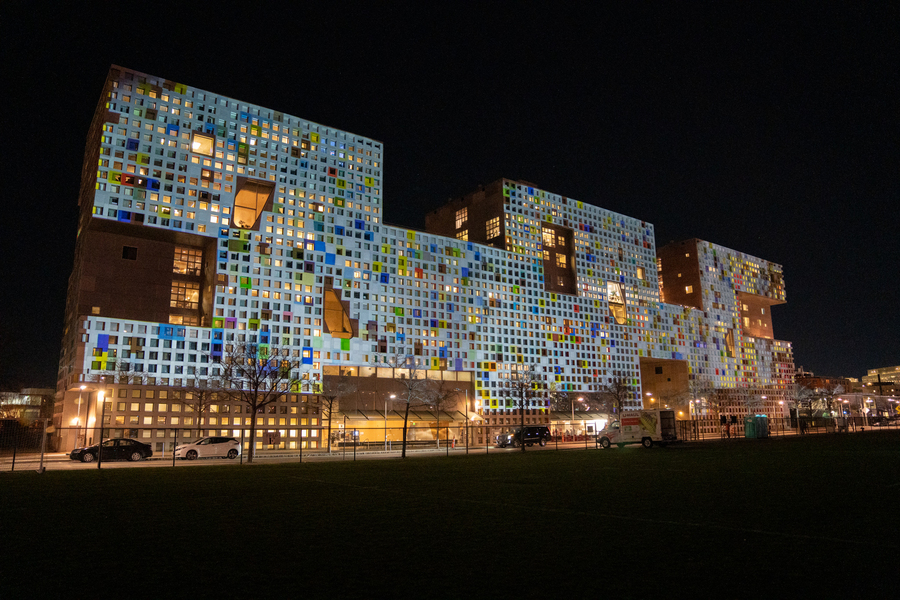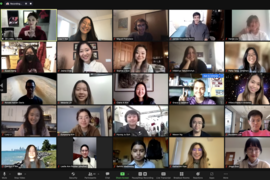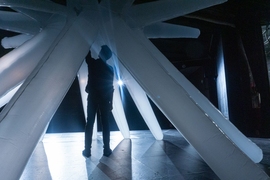It’s known on campus as “The Sponge.” But last month, undergraduate design major Karyn Nakamura transformed the iconic façade of Simmons Hall into a scintillating interactive canvas.
“I didn’t know if we would get permission to project onto Simmons,” says Nakamura, who on three successive evenings in April projected dynamic pixelated images onto Simmons’ windowed façade. She titled her installation projection “116 x 31,” after the numbers of horizontal and vertical squares that form Simmons’ metal frame. “But we did.”
Working from a table in Briggs field about 100 feet from the dorm designed for MIT by Steven Holl Architects, with a generator to power her equipment, Nakamura invited viewers to speak into a microphone. The captured audio was transformed into digital data and channeled to a computer controlling three projectors. The projectors, in turn, sent animated images onto the façade. Each metal frame on Simmons became an individual pixel. The pixels, together, composed shifting, colored forms and shapes that flickered across the façade as if on an old low-resolution computer monitor.
The ambitious project was supported with funding from the Council for the Arts at MIT (CAMIT) with additional support from the Music and Theater Arts Section and the Arts at MIT. There were many challenges and technical hurdles to overcome. “This project was different from anything I’d done before,” says Nakamura, who spends much of her time on campus in a first-floor rehearsal space in W97 experimenting with technologies, software, and materials. “Working inside, projecting onto a blank wall, I have all the time I need to experiment and revise. With this project, there were only a few opportunities for me to actually see it on the Simmons’ façade. So much had to be planned and estimated beforehand. It was only on the first night of the show that I saw everything complete.”
A faculty-student partnership
Nakamura came to MIT in 2019 intending to study physics or history. That changed in the spring of her first year when she enrolled in Joshua Higgason’s course “Interactive Design and Projection for Live Performance.” Because of Covid-19, the course soon became virtual. In March, Nakamura flew back to Japan for what she thought would be a few weeks. “Before she left, we met on the steps of her dorm and I handed her a motion-sensing camera,” says Higgason, a video, lighting, scenic, and interactive designer and a technical instructor in MIT’s Theater Arts program. “And working from Japan, she produced a brilliant final project, a digital collage of analogue images and textures that responded to frequencies of notes she played on the piano.”
Those few spring weeks Nakamura intended to spend in Tokyo became months, extending through fall and winter. She kept up with her MIT coursework through the end of 2020; during that time she learned how to in an urban design class. She took the spring 2021 semester off to work on her art, and without an audience or classmates to give feedback, she posted her creations on Instagram and developed a following.
In June, shortly before returning to campus, she contacted Higgason to ask for help finding a space on campus where she could work, uninterrupted, on her art. He found the space — a first-floor rehearsal room in the MIT Theater Arts building — and created a laboratory assistant position for her, giving her access to the space and equipment whenever she wanted. Their collaboration later morphed into an Undergraduate Research Opportunity Program. “I try to provide equipment and inspiration, and then I try to get out of her way,” says Higgason, whose own work ranges from stage projections for operas in Milan and Berlin to video and lighting design for Radiolab. “She is already excelling, soaring on projects before I can even suggest them.”
An artist unbound
Since last summer, working in her “art cave,” Nakamura has produced dozens of graphics, projections, and installations. Last September, she traveled to Montreal to participate in MAPP Montreal — a three-night projection mapping festival.
Nakamura has been active on and around campus as well. Last November, on a 6-degree Fahrenheit night, she projected the image of her laptop battery monitor onto an outdoor screen at the MIT Kendall Square Open Space. In December, she lit up the third-floor windows of the MIT Stratton Student Center with the numeral 9 — to celebrate the release of Issue 9 of MIT’s student-run Infinite Magazine. In the same month she displayed “Nothing” — an installation in Long Lounge, composed of sheets of fabric, eight box fans, four theater lights, and over 40 cables, all of which she hauled down Vassar Street in a moving cart.
She has also shared her work, process, and approach with Higgason’s students, something he says is incredibly helpful. “In Karyn we have an artist who is a peer,” says Higgason. “When students see someone their own age doing work of this caliber, they start to believe they can do the same thing.”
Nakamura, in turn, credits Higgason with helping her grow as an artist. “He’s the reason I’m able to do a project on a scale like this Simmons show,” she says. “He’s always made things so accessible to me, from handing me a camera when we thought the world was ending two years ago to carrying the 200-pound projectors we’re using for Simmons out onto the field. Beyond providing me with technical resources and knowledge, he’s created an environment where I feel comfortable exploring whatever idea my mind spits out.”









